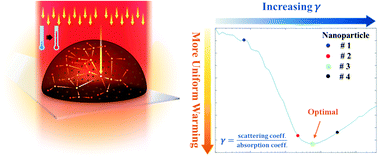Photothermal conversion of gold nanoparticles for uniform pulsed laser warming of vitrified biomaterials†
Abstract
Pulsed laser (ms, 1064 nm) gold nanoparticle (GNP) heating has been used recently to achieve fast (>10 000 000 °C min−1) warming of vitrified droplets using gold nanorods (GNRs) as photon-absorbers. To maximize the viability of biomaterials in vitrified droplets, the droplets must be warmed as uniformly as possible. A potential approach to such warming is to use an appropriate combination of photon-absorption and -scattering to distribute heat more uniformly throughout a droplet. To investigate this, 2 plasmonic gold nanorods (GNRs), 1 hollow gold nanoshell, and 2 silica-core gold nanoshells (GNSs) were synthesized and characterized under 1064 nm laser irradiation in water, propylene glycol, and protein-rich (egg white) solutions. Using a modified cuvette laser calorimetry experiment with complementary Monte Carlo modeling, the GNSs were found to have higher per-particle absorption and scattering cross sections, while the GNRs had higher photothermal conversion efficiency, absorption efficiency, and Au mass normalized absorption cross sections. In the characterization, the GNSs with larger scattering-to-absorption ratios could have ∼30% over-estimation of photothermal conversion efficiency if scattering and reabsorption inside the solution were not considered, while GNRs with lower ratios were less impacted. Combined Monte Carlo and COMSOL simulations were used to predict the specific absorption rate (W m−3) and heating behavior of GNP-loaded hemispherical droplets, thereby demonstrating that the GNS case with higher scattering-to-absorption ratio achieved more uniform heating than the GNR case. Interestingly, further tuning of the scattering and absorption coefficients of the hemispherical GNP-loaded droplet within the model suggests the ability to obtain an optimal scattering-to-absorption ratio for uniform heating. These results show the importance of considering the reabsorption of scattered light to accurately characterize the photothermal conversion efficiency of GNP solutions during laser irradiation. We also show that the relative scattering and absorption properties of the nanoparticles can be designed to promote both rapid and uniform laser rewarming of vitrified droplets for application in cryopreservation.



 Please wait while we load your content...
Please wait while we load your content...